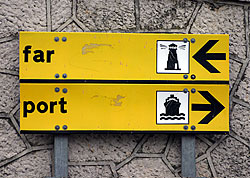History of lighthouses > Antike
It stands firmly that in the Mediterranean area already many centuries before Christi birth at the threshold between tomorrow and evening country active maritime trade took place. The idea not to only point with the help of far away a visible light boats the way into the native port but also as far away visible landmark for ship navigation to contribute, might be already very old therefore. One attributes the Greeks the first operators of beacons to have been. Already around 800 v. Chr. reported Homer of fires, and there are some Hnweise on their existence in the Nordägäis.
The oldest, really meaning lighthouse might be the well-known tower of Pharos. It is however definitely not the first lighthouse of the world, how often is to be read. The Egyptians built this tower on the Nile delta with Alexandria pre-aged an island around 300 v. Chr. Its building is to have taken 17 years. Over its appearance and its height exist today most different opinions, since many sources contradict themselves strongly. In 12. Century developed report on a journey of a maurischen prince son named Idrisi from Zeuta expresses itself in such a way that the tower from stone is to have been built, whose individual layers were connected by melted lead. Whether it served from the beginning as lighthouse and this function its priority purpose was, is today unfortunately unknown. Safe it is only that the tower partly collapsed in the year 1302 with an earthquake and was destroyed until 1349 finally. This tower was name giver for future lighthouses in many languages: The words “phare” (fr.), “faro” (splinter /ital.) and “farol” (portug.) decrease/go back all to the Egyptian forerunner, are today however firm of components of the respective languages for the word “lighthouse”.

In what respect it concerned with the sagenumwobenen” Koloss of Rhodos “against it a lighthouse, is strongly disputed and is considered as rather improbably. With the” Koloss “it is to have concerned a bronze statue of the God Helios over the port entrance of the Greek island, as it represents the illustration right. In its hand a “fire pan” is to have been, in which a beacon burned - like this to have been however maintained was, is veilful. It developed for the excessive quantity after, after Demetrios Polykletes gave the FE storage up of the port in the years 304/303 v.Chr, what the inhabitants as its victory laid out. In twelve-year-old boys construction period established it thereupon the bronze Helios statue, which is to have had a height of approx. 35 m. The exact location is just as unsettled as its appearance. “Classical” outlining as spreizbeinig figure set up over the port entrance is considered as quite improbable, possibly was the Koloss also in the center of the city. After only 66 years (224 v. Chr.) the statue fell with an earthquake over. It was not again developed, since according to for the case of the attempt a large mischief threatens a Orakel.
Approximately to this time began the rule of the Romans in the Mediterranean area, whom expanded soon also on Western Europe. The Romans organized in the coming centuries strengthen the building of the navigation marks for its war and trading vessels, so also in the North Sea e.g. close of the today's Katwijks [NL], Boulogne sur Mer [F] and Dover [GB]. Numerous stone towers were established in salient places, on whose point the guard staff maintained an open beacon. As fuel material at this time mostly harziges or wood soaked in pitch was used. Details are well-known over approximately 50 large towers, but might be much higher the number of the lighthouses actually built by the Romans. From these historical buildings exist today still three copies, which are specified in the following table:
| Name | Nation | Year of construction | Actively | Remarks |
|---|---|---|---|---|
| Frejus | France | approx. 0 | 0? | |
| Novel Pharos, Dover | Great Britain | approx. 50 | approx. 50 -? | |
| Torre de Hercules, La Coruña | Spain | approx. 100 | approx. 100 - today | Longer interruptions of the beacon enterprise, tower one reconstructed repeated and one changed |
With the fall of the Roman realm turned to the coasts of Europe against 500 n. Chr. again darkness back. Without a superordinate organization there was no control and motivation for the maintenance of beacons. The peoples along the coasts were delivered plündernden pirates and attached little importance to betray by beacons along the coast this also still their exact location. The era of the beacons was first of all again terminated thereby.

